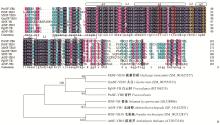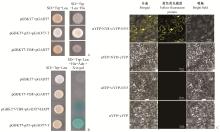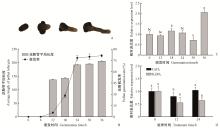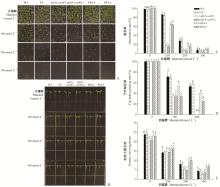

Scientia Silvae Sinicae ›› 2021, Vol. 57 ›› Issue (5): 77-92.doi: 10.11707/j.1001-7488.20210508
Previous Articles Next Articles
Yahui Miao,Dan Ju,Kehao Liang,Aibin Wang,Junling Liu,Lingyun Zhang*
Received:2020-06-22
Online:2021-07-25
Published:2021-07-09
Contact:
Lingyun Zhang
CLC Number:
Yahui Miao,Dan Ju,Kehao Liang,Aibin Wang,Junling Liu,Lingyun Zhang. Cloning and Functional Analysis of Transcription Factor Gene PwNF-YB8 from Picea wilsonii[J]. Scientia Silvae Sinicae, 2021, 57(5): 77-92.
Table 1
Primers used in this experiment"
| 用途 Application | 引物名称 Primer name | 序列 Sequence(5′—3′) | |
| 实时定量反转录 PCR qRT-PCR | YB8 | F: ATGGCGGAAGCTAGCAGTCCG | R: TCATGACAGATCATTGCCCTG |
| EF1-α | F: AACTGGAGAAGGAACCCAAG | R: AACGACCCAATGGAGGATAC | |
| YB8-RT-F | F: GGAGGGTGACAATAAGGGATCTTC | R: CTGCATTGTCACCATATGATGCTG | |
| Actin2/8 | F: GGTAACATTGTGCTCAGTGGTGG | R: AACGACCTTAATCTTCATGCTGC | |
| 载体构建 Vector construction | AD-8-F | F: TCCCCCGGGATGGCGGAAGCTAGCAG | R: CGCGGATCCTCATGACAGATCATTGC |
| BD-5-F | F: GGAATTCCATATGATGGATCAGCAGCAGCC | R: CGCGGATCCTCAACTGCTGCCATGAG | |
| YB8-bifc |  |  | |
| HAP5-bifc |  |  | |
| YB8-1205 | F: CGGAATTCATGGCGGGAAGCTAGCAGTCCG | R: GGTACCCCTGACAGATCATTGCCCTGC | |
| 8-SUPER |  |  | |
| DT1-BsF-4 | ATATATGGTCTCGATTGTAGCGATTTTCCCATTAGCGTT | ||
| DT1-F0-4 | TGTAGCGATTTTCCCATTAGCGTTTTAGAGCTAGAAATAGC | ||
| DT2-R0-8 | AACATTAGCAGGAAGACCTCTTCAATCTCTTAGTCGACTCTAC | ||
| DT2-BsR-8 | ATTATTGGTCTCGAAACATTAGCAGGAAGACCTCTTC | ||
| 突变体鉴定 Mutant identification | Crispr 8 | F: TCTGTTGATGGGTTTTGTCTATTTTG | R: GCCTCAACTTTCACTAGTTAAGAAAAAC |

Fig.2
Multiple sequence alignment and evolutionary tree analysis of PwNF-YB8 and homologous proteins A: Homologous protein multiple sequence alignment Conserved percent: Black=100%, Pink≥75%, Blue≥50%; The thick line indicates the NF-YB conserved domain, the helical domains (α1, α2, α3, αc) in the figure are represented by black boxes, in which a loop (L1, L2, L3) is formed between every two helical structures; Arginine located at L2 and aspartic acid placed α3 act on the binding of NF-YB and NF-YC, and the two glutamic acids located in α2 play a role in the binding of NF-YA. B: Phylogenetic tree analysis."


Fig.5
Analysis of transcriptional activation activity of PwNF-YB8 and its interaction with PwHAP5 A: PwNF-YB8 transcriptional activation activity; B: Yeast two-hybrid PwNF-YB8 and PwHAP5 interaction; C: PwNF-YB8 and PwHAP5 bimolecular fluorescence complementary experiment analysis, Bar=50 μm."


Fig.6
Germination of Picea wilsonii pollen and expression of PwNF-YB8 in the process of pollen germination A: Pollen morphology during normal germination; B: Statistics of pollen tube length and germination rate during pollen germination; C: Relative expression of PwNF-YB8 during pollen germination; D: Relative expression of PwNF-YB8 induced by calcium chloride and boric acid."


Fig.7
Sequencing peak map of Arabidopsis thaliana mutant plants and protein sequence of A. thaliana wild-type plants and mutant plants A: AtNF-YB8 gene target site mutation pattern; B: Sequencing peak map of Arabidopsis mutant plants(* indicates the location of the increased bases in the sequencing peak map of the mutant plant compared to the wild type plant); C: Arabidopsis mutant encoding AtNF-YB protein sequence."


Fig.8
Obtaining and identification of transgenic PwNF-YB8 plants of Arabidopsis thaliana A: PCR identification of overexpressing lines(M: DL2000 marker; Col: Negative control; P: Positive control; 1-6: Different positive plants); B: PwNF-YB8 expression analysis in wild type(WT) and overexpressing lines(P8-L4, P8-L5)."


Fig.9
Seed germination rate and seedling root length of different lines of Arabidopsis thaliana under different concentrations treatments of mannitol WT: Wild type; VC: Empty vector control; P8-L4, P8-L5: Overexpressing plants; nfyb8-cas9#1, nfyb8-cas9#12: Mutant plants. The same below. A, C: Statistics of germination rate under mannitol treatment; D: Statistics of cotyledon greening rate under mannitol treatment; B, E: Statistics of seedling root length under mannitol treatment."

| 鞠丹. 2017. 青杄转录因子NF-YB8/13表达特性分析及在花粉萌发中功能探究. 北京: 北京林业大学硕士学位论文. | |
| Ju D. 2017. The expression and interaction analysis of NF-YB8 and NF-YB13 transcription factor from Picea wilsonii during pollen germination. Beijing: MS thesis of Beijing Forestry University. [in Chinese] | |
| 梁明祥, 刘赵普, David Hole, 等. 2010. HAP3b基因负调控植物冷害反应. 南京: 中国植物学会植物细胞生物学2010年学术年会. | |
| Liang M X, Liu Z P, David H, et al. 2010. HAP3b gene negatively regulates plant chilling injury response. Nanjing: Chinese Academy of Botany Plant Cell Biology 2010 Annual Conference. [in Chinese] | |
| 马晓闻. 2016. 牛心朴子草逆境胁迫转录组分析与CkNF-YB1、CkEDS1的功能研究. 北京: 中国农业大学博士学位论文. | |
| Ma X W. 2016. Transcriptome analysis of stress response in Cynanchum komarovii and functional study of the genes CkNF-YB1 and CkEDS1. Beijing: PhD thesis of China Agricultural University. [in Chinese] | |
| 王鼎慧, 李永光, 李真, 等. 转GmHAP3-17基因大豆的抗旱性分析. 大豆科学, 2015, 34 (2): 249- 254. | |
| Wang D H , Li Y G , Li Z , et al. Aanalysis of drought tolerance in transgentic soybean with GmHAP3-17. Soybean Science, 2015, 34 (2): 249- 254. | |
| 许家春, 邵海燕, 李殿波. 优良绿化树种青杄云杉引种栽培技术. 中国林副特产, 2004, (3): 24- 25. | |
| Xu J C , Shao H Y , Li D B . Introduction and plantation technology of Picea wilsonii, a superior landscape planting species. Forest By-Product and Speciality in China, 2004, (3): 24- 25. | |
| 张盾, 刘亚静, 李长江, 等. 青杄均一化cDNA文库构建及EST序列分析. 生物技术通报, 2012, (6): 71- 76. | |
| Zhang D , Liu Y J , Li C J , et al. Construction of normalized cDNA library and analysis of corresponding EST sequences in Picea wilsonii. Biotechnology Bulletin, 2012, (6): 71- 76. | |
| 张通, 李巧玲, 张凌云. PwEXP1在青杄种子萌发及逆境响应中的表达特征. 林业科学, 2014, 50 (12): 56- 62. | |
| Zhang T , Li Q L , Zhang L Y . Expression characteristics of PwEXP1 gene in seed germination and adversity in Picea wilsonii. Scientia Silvae Sinicae, 2014, 50 (12): 56- 62. | |
|
Ballif J , Endo S , Kotani M , et al. Over-expression of HAP3b enhances primary root elongation in Arabidopsis. Plant Physiology and Biochemistry, 2011, 49 (6): 579- 583.
doi: 10.1016/j.plaphy.2011.01.013 |
|
|
Bello B K , Hou Y X , Zhao J J , et al. NF-YB1-YC12-bHLH144 complex directly activates Wx to regulate grain quality in rice (Oryza sativa L.). Plant Biotechnol Journal, 2019, 17 (7): 1222- 1235.
doi: 10.1111/pbi.13048 |
|
|
Cai X N , Ballif J , Endo S , et al. A putative CCAAT-binding transcription factor is a regulator of flowering timing in Arabidopsis. Plant Physiology, 2007, 145 (1): 98- 105.
doi: 10.1104/pp.107.102079 |
|
| Chen N Z , Zhang X Q , Wei P C , et al. AtHAP3b plays a crucial role in the regulation of flowering time in Arabidopsis during osmotic stress. Journal of Biochemistry and Molecular Biology, 2007, 40 (6): 1083- 1089. | |
|
Chen Y L , Yang Z E , Xiao Y Q , et al. Genome-wide analysis of the NF-YB gene family in Gossypium hirsutum L.and characterization of the role of GhDNF-YB22 in embryogenesis. International Journal of Molecular Sciences, 2018, 19 (2): 483.
doi: 10.3390/ijms19020483 |
|
|
Clough S J , Bent A F . Floral dip: a simplified method for Agrobacterium-mediated transformation of Arabidopsis thaliana. The Plant Journal, 1998, 16 (6): 735- 743.
doi: 10.1046/j.1365-313x.1998.00343.x |
|
|
Das S , Parida S K , Agarwal P , et al. Transcription factor OsNF-YB9 regulates reproductive growth and development in rice. Planta, 2019, 250 (6): 1849- 1865.
doi: 10.1007/s00425-019-03268-2 |
|
|
E Z G , Li T T , Zhang H Y , et al. A group of nuclear factor Y transcription factors are sub-functionalized during endosperm development in monocots. Journal of Experimental Botany, 2018, 69 (10): 2495- 2510.
doi: 10.1093/jxb/ery087 |
|
|
Edwards D , Murray J A , Smith A G . Multiple genes encoding the conserved CCAAT-box transcription factor complex are expressed in Arabidopsis. Plant Physiology, 1998, 117 (3): 1015- 1022.
doi: 10.1104/pp.117.3.1015 |
|
| Frontini M , Imbriano C , Manni I , et al. Cell cycle regulation of NF-YC nuclear localization. Cell Cycle, 2004, 3 (2): 217- 222. | |
| Guo Y X , Zhang H H , Yuan Y H , et al. Identification and characterization of NAC genes in response to abiotic stress conditions in Picea wilsonii using transcriptome sequencing. Biotechnology & Biotechnological Equipment, 2020, 34 (1): 93- 103. | |
|
Hackenberg D , Wu Y F , Voigt A , et al. Studies on differential nuclear translocation mechanism and assembly of the three subunits of the Arabidopsis thaliana transcription factor NF-Y. Molecular Plant, 2012a, 5 (4): 876- 888.
doi: 10.1093/mp/ssr107 |
|
|
Hackenberg D , Keetman U , Grimm B . Homologous NF-YC2 subunit from Arabidopsis and tobacco is activated by photooxidative stress and induces flowering. International Journal of Molecular Sciences, 2012b, 13 (3): 3458- 3477.
doi: 10.3390/ijms13033458 |
|
|
Han X , Tang S , An Y , et al. Overexpression of the poplar NF-YB7 transcription factor confers drought tolerance and improves water-use efficiency in Arabidopsis. Journal of Experimental Botany, 2013, 64 (14): 4589- 4601.
doi: 10.1093/jxb/ert262 |
|
|
Hooft V H R , Li X Y , Black D , et al. Co-evolution from yeast to mouse: cDNA cloning of the two NF-Y (CP-1/CBF) subunits. Embo Journal, 1990, 9 (10): 3119- 3127.
doi: 10.1002/j.1460-2075.1990.tb07509.x |
|
|
Kim S , Park H , Jang Y H , et al. OsNF-YC2 and OsNF-YC4 proteins inhibit flowering under long-day conditions in rice. Planta, 2016, 243 (3): 563- 576.
doi: 10.1007/s00425-015-2426-x |
|
|
Kumimoto R W , Zhang Y , Siefers N , et al. NF-YC3, NF-YC4 and NF-YC9 are required for CONSTANS-mediated, photoperiod-dependent flowering in Arabidopsis thaliana. Plant Journal, 2010, 63 (3): 379- 391.
doi: 10.1111/j.1365-313X.2010.04247.x |
|
|
Li L L , Yu Y L , Wei J , et al. Homologous HAP5 subunit from Picea wilsonii improved tolerance to salt and decreased sensitivity to ABA in transformed Arabidopsis. Planta, 2013, 238 (2): 345- 356.
doi: 10.1007/s00425-013-1894-0 |
|
|
Liu C , Sun Q H , Zhao L , et al. Heterologous expression of the transcription factor EsNAC1 in Arabidopsis enhances abiotic stress resistance and retards growth by regulating the expression of different target genes. Frontiers in Plant Science, 2018, 9, 1495.
doi: 10.3389/fpls.2018.01495 |
|
|
Liu J X , Howell S H . bZIP28 and NF-Y transcription factors are activated by ER stress and assemble into a transcriptional complex to regulate stress response genes in Arabidopsis. The Plant Cell, 2010, 22 (3): 782- 796.
doi: 10.1105/tpc.109.072173 |
|
| Maheshwari P , Kummari D , Palakolanu S R , et al. Genome-wide identification and expression profile analysis of nuclear factor Y family genes in Sorghum bicolor L.(Moench). PLoS ONE, 2019, 14 (9) | |
|
Maity S N , Vuorio T , de Crombrugghe B . The B subunit of a rat heteromeric CCAAT-binding transcription factor shows a striking sequence identity with the yeast Hap2 transcription factor. Proceeding of the National Academy of Science of the United States of America, 1990, 87 (14): 5378- 5382.
doi: 10.1073/pnas.87.14.5378 |
|
|
Mantovani R . The molecular biology of the CCAAT-binding factor NF-Y. Gene, 1999, 239 (1): 15- 27.
doi: 10.1016/S0378-1119(99)00368-6 |
|
|
Miyoshi K , Ito Y , Serizawa A , et al. OsHAP3 genes regulate chloroplast biogenesis in rice. Plant Journal, 2003, 36 (4): 532- 540.
doi: 10.1046/j.1365-313X.2003.01897.x |
|
|
Nakashima A , Chen L , Thao N P , et al. RACK1 functions in rice innate immunity by interacting with the Rac1 immune complex. Plant Cell, 2008, 20 (8): 2265- 2279.
doi: 10.1105/tpc.107.054395 |
|
|
Nelson D E , Repetti P P , Adams T R , et al. Plant nuclear factor Y (NF-Y) B subunits confer drought tolerance and lead to improved corn yields on water-limited acres. Proceeding of the National Academy of Science of the United States of America, 2007, 104 (42): 16450- 16455.
doi: 10.1073/pnas.0707193104 |
|
|
Ni Z Y , Hu Z , Jiang Q Y , et al. GmNFYA3, a target gene of miR169, is a positive regulator of plant tolerance to drought stress. Plant Molecular Biology, 2013, 82 (1/2): 113- 129.
doi: 10.1007/s11103-013-0040-5 |
|
| Olesen J T , Fikes J D , Guarente L . The Schizosaccharomyces pombe homolog of Saccharomyces cerevisiae HAP2 reveals selective and stringent conservation of the small essential core protein domain. Molecular and Cellular Biology, 1991, 11 (2): 611- 619. | |
|
Peng D , Jiang Y Q , Liu X M , et al. Molecular characterization of a CONSTANS gene from Sapium sebiferum (L.) Rxob. Gene, 2018, 654, 69- 76.
doi: 10.1016/j.gene.2018.02.042 |
|
|
Ripodas C , Castaingts M , Clua J , et al. The PvNF-YA1 and PvNF-YB7 subunits of the heterotrimeric NF-Y transcription factor influence strain preference in the Phaseolus vulgaris-Rhizobium etli symbiosis. Frontiers in Plant Science, 2019, 10, 221.
doi: 10.3389/fpls.2019.00221 |
|
|
Romier C , Cocchiarella F , Mantovani R , et al. The NF-YB/NF-YC structure gives insight into DNA binding and transcription regulation by CCAAT factor NF-Y. Journal of Biological Chemistry, 2003, 278 (2): 1336- 1345.
doi: 10.1074/jbc.M209635200 |
|
|
Sato H , Mizoi J , Tanaka H , et al. Arabidopsis DPB3-1, a DREB2A interactor, specifically enhances heat stress-induced gene expression by forming a heat stress-specific transcriptional complex with NF-Y subunits. The Plant Cell, 2014, 26 (12): 4954- 4973.
doi: 10.1105/tpc.114.132928 |
|
|
Siefers N , Dang K K , Kumimoto R W , et al. Tissue-specific expression patterns of Arabidopsis NF-Y transcription factors suggest potential for extensive combinatorial complexity. Plant Physiology, 2009, 149 (2): 625- 641.
doi: 10.1104/pp.108.130591 |
|
|
Stephenson T J , Mcintyre C L , Collet C , et al. TaNF-YB3 is involved in the regulation of photosynthesis genes in Triticum aestivum. Functional and Integrative Genomics, 2011, 11 (2): 327- 340.
doi: 10.1007/s10142-011-0212-9 |
|
|
Sun X D , Lian H F , Liu X C , et al. The garlic NF-YC gene, AsNF-YC8, positively regulates non-ionic hyperosmotic stress tolerance in tobacco. Protoplasma, 2017, 254 (3): 1353- 1366.
doi: 10.1007/s00709-016-1026-3 |
|
|
Thirumurugan T , Ito Y , Kubo T , et al. Identification, characterization and interaction of HAP family genes in rice. Molecular Genetics and Genomics, 2008, 279 (3): 279- 289.
doi: 10.1007/s00438-007-0312-3 |
|
|
Wang B M , Li Z X , Ran Q J , et al. ZmNF-YB16 overexpression improves drought resistance and yield by enhancing photosynthesis and the antioxidant capacity of maize plants. Frontiers in Plant Science, 2018a, 9, 709.
doi: 10.3389/fpls.2018.00709 |
|
| Wang Y , Xu W , Chen Z X , et al. Gene structure, expression pattern and interaction of Nuclear Factor-Y family in castor bean (Ricinus communis). Planta, 2018b, 247 (2): 559- 572. | |
|
Wang P Q , Ma G L , Zhang L J , et al. A sucrose-induced MYB (SIMYB) transcription factor promoting proanthocyanidin accumulation in the tea plant (Camellia sinensis). Journal of Agricultural and Food Chemistry, 2019a, 67 (5): 1418- 1428.
doi: 10.1021/acs.jafc.8b06207 |
|
|
Wang R K , Zhu L , Zhang Y , et al. Genome-wide analysis of poplar NF-YB gene family and identified PtNF-YB1 important in regulate flowering timing in transgenic plants. BMC Plant Biology, 2019b, 19 (1): 251.
doi: 10.1186/s12870-019-1863-2 |
|
|
Wei Q , Ma C , Xu Y J , et al. Control of chrysanthemum flowering through integration with an aging pathway. Nature Communications, 2017, 8 (1): 829.
doi: 10.1038/s41467-017-00812-0 |
|
|
Wei Q , Wen S Y , Lan C Y , et al. Genome-wide identification and expression profile analysis of the NF-Y transcription factor gene family in Petunia hybrida. Plants, 2020, 9 (3): 336.
doi: 10.3390/plants9030336 |
|
|
Wenkel S , Turck F , Singer K , et al. CONSTANS and the CCAAT box binding complex share a functionally important domain and interact to regulate flowering of Arabidopsis. Plant Cell, 2006, 18 (11): 2971- 2984.
doi: 10.1105/tpc.106.043299 |
|
|
Yang M Y , Zhao Y J , Shi S Y , et al. Wheat nuclear factor Y (NF-Y) B subfamily gene TaNF-YB3;1 confers critical drought tolerance through modulation of the ABA-associated signaling pathway. Plant Cell, Tissue and Organ Culture, 2017, 128 (1): 97- 111.
doi: 10.1007/s11240-016-1088-0 |
|
|
Yu Y L , Li Y Z , Huang G X , et al. PwHAP5, a CCAAT-binding transcription factor, interacts with PwFKBP12 and plays a role in pollen tube growth orientation in Picea wilsonii. Journal of Experimental Botany, 2011, 62 (14): 4805- 4817.
doi: 10.1093/jxb/err120 |
|
|
Zhang H H , Cui X Y , Guo Y X , et al. Picea wilsonii transcription factor NAC2 enhanced plant tolerance to abiotic stress and participated in RFCP1-regulated flowering time. Plant Molecular Biology, 2018, 98 (6): 471- 493.
doi: 10.1007/s11103-018-0792-z |
|
| Zhang Z B , Li X L , Zhang C , et al. Isolation, structural analysis, and expression characteristics of the maize nuclear factor Y gene families. Biochemical & Biophysical Research Communications, 2016, 478 (2): 752- 758. | |
|
Zhou Y Y , Zhang Y , Wang X W , et al. Root-specific NF-Y family transcription factor, PdNF-YB21, positively regulates root growth and drought resistance by abscisic acid-mediated indoylacetic acid transport in Populus. New Phytologist, 2020, 227 (2): 407- 426.
doi: 10.1111/nph.16524 |
| [1] | Xinyi Zhou,Liqiong Yan,Yuntong Lü,Lili Sun,Jingwen Zhu,Chuanwang Cao. Activities and Gene Expressions of Phenylpropane Metabolic Enzymes in Populus simonii×P. nigra by Herbivore Induction of Lymantria dispar (Lepidoptera: Lymantriidae) [J]. Scientia Silvae Sinicae, 2021, 57(3): 108-116. |
| [2] | Minhao Liu,Long Li,Jing Ye,Xuanyuan Zhou,Zhouqi Li,Ruishen Fan,Junlei Xu. Genome-Wide Identification and Expression Analysis of the ARF Gene Family in Eucommia ulmoides [J]. Scientia Silvae Sinicae, 2021, 57(3): 170-180. |
| [3] | Wenqing Jia,Yanli Wang,Yingzi Guo,Zheng Wang,Qing Qi,Sanni Yan,Huichao Liu,Songlin He. Characterization of Pollen Germination and Storage of Paeonia ludlowii [J]. Scientia Silvae Sinicae, 2021, 57(2): 82-92. |
| [4] | Limin Wang,Yahui Chen,Qingshan Yang,Ritao Qu,Jiang Jiang,Jinchi Zhang,Hongxia Zhang,Zhizhong Song. Cloning and Functional Analysis of Potassium Channel Gene PdbSKOR in Populus davidiana×P. bolleana [J]. Scientia Silvae Sinicae, 2021, 57(1): 53-63. |
| [5] | Chenglei Zhu,Kebin Yang,Xiurong Xu,Shuang Ma,Xiaopei Li,Zhimin Gao. Molecular Characteristics of NIP Genes in Phyllostachys edulis and Their Expression Patterns in Response to Stresses [J]. Scientia Silvae Sinicae, 2021, 57(1): 64-76. |
| [6] | Weibo Sun,Xindong Gong,Yan Zhou,Hongyan Li. Photosynthetic Characteristics of Transgenic Poplars with Maize PEPC and PPDK Gene at Young Plant Stage [J]. Scientia Silvae Sinicae, 2020, 56(7): 33-43. |
| [7] | Zhongyuan Liu,Zheng Liu,Ying Xu,Shanshan Liu,Zhilan Tian,Qingjun Xie,Caiqiu Gao. Cloning and Salt Tolerance Analysis of Transcription Factor HSFA4 from Betula platyphylla [J]. Scientia Silvae Sinicae, 2020, 56(5): 69-79. |
| [8] | Bi Liang,Jiaqi Zhang,Fei Ren,Hengkang Hu,Chuanmei Xu,Yuanyuan Hu,Youjun Huang,Heqiang Lou,Qixiang Zhang. Cloning and Expression Analysis of Ent-Kaurene Oxidase Gene CcKo in Carya cathayensis [J]. Scientia Silvae Sinicae, 2020, 56(10): 70-82. |
| [9] | Zhang Chao, Wang Jinmao, Zhao Jie, Pang Dingwei, Zhang Dejian, Yang Minsheng. Expression Characteristics of Bt Gene in Transgenic Poplar Transformed by Different Multi-Gene Vectors [J]. Scientia Silvae Sinicae, 2019, 55(9): 61-70. |
| [10] | Liu Daofeng, Wang Xia, Dai Yin, Yang Jianfeng, Ma Jing, Li Mingyang, Sui Shunzhao. Cloning and Function Analysis of CpTAF10 from Wintersweet (Chimonanthus praecox) [J]. Scientia Silvae Sinicae, 2019, 55(6): 176-183. |
| [11] | Lu Huijun, Li Ziyi, Liang Hanyu, Yue Yuanzhi, Zhou Tianchang, Yang Yuzhang, Wang Yucheng, Ji Xiaoyu. Expression and Stress Tolerance Analysis of NAC24 from Tamarix hispida [J]. Scientia Silvae Sinicae, 2019, 55(3): 54-63. |
| [12] | Fan Weijian, Xiang Weifang, Wang Jing, Bai Penghua, Pan Lina, Yang Yixin, Zhu Gengping, Li Min. Effects of Insecticides and Ultraviolet on the Expression of sHSP12.2 Gene in Chouioia cunea [J]. Scientia Silvae Sinicae, 2019, 55(2): 128-136. |
| [13] | Yue Wang,Sufang Zhang,Yao Xu,Fu Liu,Xiangbo Kong,Zhen Zhang. Cloning and Expression Profiles of HcSID-1 Gene and Its Function Verification in Hyphantria cunea Larvae [J]. Scientia Silvae Sinicae, 2019, 55(10): 48-56. |
| [14] | Zhang Yang, Du Lin, Tang Xianfeng, Liu Huanhuan, Zhou Gongke, Chai Guohua. Identification and Expression Pattern Analyses of Populus BAG Genes [J]. Scientia Silvae Sinicae, 2019, 55(1): 138-145. |
| [15] | Wei Mingke, Yu Jinjian, Huang Xiaolong, Liu Qiongyao, Huang Huahong, Lin Erpei, Tong Zaikang. Cloning, Expression and Single Nucleotide Polymorphisms Analysis of NAC Transcription Factor Gene ClNAC1 in Cunninghamia lanceolata [J]. Scientia Silvae Sinicae, 2018, 54(9): 49-59. |
| Viewed | ||||||
|
Full text |
|
|||||
|
Abstract |
|
|||||